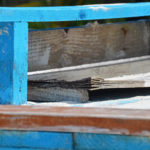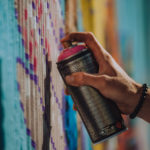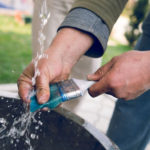A primer coat, also known as an undercoat, is an initial coating that is applied on surfaces before the painting process begins. It is a type of liquid coating that gels well with a wide range of surfaces.
It is referred to as an undercoat for the simple reason that it is the initial layer you apply when painting materials. It also increases the paint’s durability and provides additional protection for the materials about to be painted.
The core role of a primer is to ensure that paint sticks on the surface.
When Should I Use One Coat of Primer?
In case you find out that you only need to use one coat of primer and that will be good. It will keep the overall cost of painting low and save you time as well. Discussed below are the instances one may be required to use only one coat of primer.
- Slight color change. In case there is a slight color change, you will require only one coat of primer. A good example is if the wall has a tan color and you want to paint it white. You surely will need only one primer coat layer.
- Glossy paint. In case your previous walls had latex or oil paint, you will only require one prime coat layer. It is critical to know about the previous paint and be sure about it before continuing with the painting project. This is because some paints like latex will not stick at all to an oil enamel surface.
- Stains. If the primer you are using contains a stain-blocking powder, then one coat of it will be sufficient. The type of stain has a big impact on the number of coats you apply. You should be aware of the type of primer you are getting before the process kicks off.
- Green board. One thing you should know about the green board is that it is water-resistant drywall. You will most likely find it in kitchens, bathrooms, and other areas that experience constant wet and humid conditions. A green board will require just one coat of primer. It will provide an ideal canvas for the new paint coat.
- Primer and paint in one. If you happen to get the paints that are marketed as paint & primer in one, then you will likely be required to use one coat of primer.
- Dry wall. One thing you should know is that priming over drywall directly is one of the best ways to get a beautiful look. It is something common in new homes but also works well when you are remodeling. If you are painting directly on drywall, you will need just one coat of primer.
- Painted wood. If you are painting over wood with older paint on it, you will require one coat of primer. You should know that primer adheres very well to wood. All you need is to do is scrape off the older paint as much as you can. This allows the new paint and the primer to last for an extended period.
- Unpainted wood. Just like painted wood, this one will call for one coat of primer. It is great news for an individual looking for an inexpensive and quality paint project.
When Should I Use Two Coats?
There are instances where one would require at least two coats of primer for their painting projects. Let us have a look at them.
- If you find yourself painting over a dark wall. In case you are painting over a dark color like maroon, black or brown, you will need more than just one coat of primer. The reason for this is because one coat of primer will not be able to get rid of that dark shade.
- Unfinished drywall. In case you are painting over unfinished drywall, you will face a couple of challenges like blotches, bubbles that will not absorb the prime coat efficiently. You will be required to apply more than just one coat over it.
- If it seems like more is needed. If it looks like what you have done is just not enough, you need to add another prime coat layer. A priming job is regarded as good if it covers much of the previous color. If not, you will need another prime coat layer.
How Many Coats of Primer do I Need to Apply on the New Drywall?
For new drywall, you are going to use just one coat of primer. For this case, you will not need a stain-blocking powder. You can use one coat of drywall primer that makes it an inexpensive painting project.
How Many Coats of Primer Do I Need to Use on a Painted Wall?
If the wall has pre-existing bright or dark-colored paint, you will be required to use two or three coats of primer. They will help in creating a great bond between the new paint and the wall.
The two or three coats of primer will help cover up the previous colors effectively and ensure your project ends in perfection.
How Many Coats of Primer Do I Need to Use on Bare Wood?
You must be aware that bare wood is one of the most porous wall materials. If you use the traditional 24-hour oil-based primer, you will need at least two coats.
For latex and newer oil primers, two coats will be sufficient to provide a fine finish. If you happen to use a water-based primer, you will notice that the wood may swell up a little bit.
What you should do, however, is sand the surface slightly once the first coat has dried up.
How Many Coats of Primer Do I Need to Use on a Metal Surface?
For a metal surface, you will need to apply two coats of primer. While doing so, ensure that you can cover every inch of the metal to effectively prevent the corrosion effect.
While applying the primer coats, do it in straight lines. This helps in ensuring an even application of the primer coat. You should wait for approximately twenty-four hours before applying the second layer of the primer coat.
How Many Coats of Primer Do I Need to Use on Cabinets?
For a cabinet, you only need to apply one coat of primer. This is if the cabinets are not of a dark color.
In case they are dark, an additional coat of primer will be required. Applying a coat of primer on a cabinet ensures the paint adheres to the surface effectively making it look good for an extended period.
How Many Coats of Primer Do I Need to Use on Exterior Wood?
More often than not, the exterior wood is typically in an unfinished or raw state. You will need two coats of primer for exterior wood.
The rough surface of the exterior wood absorbs much of the first coat of primer. The second coat of primer provides a perfect finish by filling out most of the remaining spots. You should use water or oil-based primer for this kind of project.
How Many Coats of Primer Do I Need to Use on Stained Wood?
For stained wood, an oil-based primer is highly recommended. You will be required to apply two coats of primer on stained wood.
After applying the first coat of primer, you need to give it ample time to dry up. It may take about a day to do so. Then you will apply the second layer and the finish will be even.
This will be a perfect foundation for the paint you will be applying on this wood.
How Many Coats of Primer Should I Use on a Car?
With regards to a car, you need to choose a high-quality automotive primer. It must be designed and developed for use of metallic surfaces.
Another thing you must first get done with is, ensuring that the part of the car you want to paint is cleaned well before beginning the process.
Having said that, you should apply about two or more coats of primer and see to it that the bare metal surface is covered completely.
How Many Coats of Primer Do I Need to Use on a Bumper?
For a bumper, you need to use two to three coats of primer. This will depend on the lightness of the coat.
After applying the first coat, leave it for about a quarter of an hour or more before applying the next layer. This will have given it sufficient time to dry.
How Many Coats of Primer Should I Use on Wood Trim?
When it comes to the case of wood trim, you only need a least two coats of primer. Be patient and let the first coat dry completely before moving on to the next one.
It will be a firm foundation for the paint you will apply to the wood trim. It will provide a smooth and evenly finished surface that will blend well with the paint.
How Many Coats of Primer Should I Use on the Fiberglass Door?
For a fiberglass door, you need to apply two thin coats of primer. Ensure that the first coat dries up completely before moving on to the next one. Doing this will provide a smooth base for the paint you are planning on applying.
How Many Coats of Primer on the RC Car?
Painting your remote control car makes it stand out from the crowd. You have to prepare your RC car for the painting process to give you a realistic look.
After doing the cleaning and sanding of the RC car, you can start applying the primer. Applying a base coat of primer will allow you to note any imperfections on the body.
Early detection of flaws is key to having a fine uniform finish. Sand down all the defects to gain a smooth uniform body. Continue applying the primer coat layers until the whole body is covered evenly.
How Many Coats of Primer on a Vinyl Turntable?
Vinyl material seems hard to paint. If you treat it like a wall, you will have a hard time painting. Most paint cannot stick to plastics like vinyl.
You have to prime the vinyl with a proper primer meant for plastics. Start by cleaning the vinyl plate with a rag soaked in warm water and soap.
Leave the plate to dry or use another clean cloth to dry it. Use a spray primer for plastics to prime the turntable.
Start with a single thin coat as instructed in the product guide. Leave the turntable to dry for about an hour and spray a second coat. From there, you can apply paint made for plastics.
How Many Coats of Primer on the Cement Board?
Cement boards are used in most homes for backing walls, tiles, and floors. Painting your cement board requires preparation.
Before anything, you have to clean the surface and let it dry. Give it like two days to dry as the paint will not stick to a wet surface.
Priming the board prevents future cracking and bubbles on board. Use a solvent cement with plastic resin primer.
This will help the paint to stick on the cement board. Apply two layers of primer to ensure the surface is uniform.
The first layer is soaked by the surface, while the second will hide any flaws giving you an even surface. Give a break of about an hour for drying before plying the second layer.
How Many Coats of Primer on the Interior Wall?
Interior walls can be painted and repainted depending on the owner’s taste or renovation trends. If you want to paint a light color over a white wall you probably need one coat of primer before painting.
Other walls may be unfinished wood or bare drywall. In this case, you need two layers of primer. The first layer may soak in the material while the second will bring uniformity.
If your wall has previous bright or dark color paint, you need two-three coats of primer. This is to ensure the old color and pores are covered well.
Also, primers create a good bond between the wall and the new paint. In each case, allow the primer to dry before applying the second layer.
How Many Coats of Primer on Miniatures?
The amount of primer applied to a miniature will determine its final look. Several layers of primer are needed on the miniature before painting.
Two-three layers of primer are enough and allow the paint to adhere in an even mode. Use a thin coat of the primer and allow it to dry before applying the next coat.
Start with a small part and progress to the next. The primer dries quickly and, you may not control the effects for a big area. Working on a small part will also help you to maintain the fine details of the miniature.
How Many Coats of Primer on the Shed?
Almost all sheds are made of wood. To paint the woodshed, you need two layers of primer for a proper seal.
For traditional 24- hour oil primers, you need one-two coats, while the latex and newer oil-based primer need two coats.
In case you use a water-based primer, sand the surface lightly after the first coat has dried. This is because the wood may absorb water and swell slightly. Metal-made sheds will need two layers of primer before painting.
Conclusion
We must recognize that priming is a tedious and tiring task. Many people would prefer skipping it and go directly to painting their intended surfaces.
However, priming is critical if you want to achieve excellent results on your painting project. It is, therefore, worth every extra effort you put into it.




